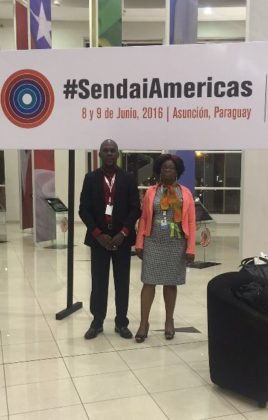- June 23, 2016
- Posted by: cdc
- Categories: News, News

It is critical that the priority areas of the Sendai Framework for disaster risk reduction be implemented in Guyana’s national programme even as the country has made significant strides in disaster risk management and risk reduction.
Over the last six years, the Civil Defence Commission (CDC) has been able to establish that the country’s low-lying areas, floods and droughts are disaster risks and it has taken measures to address these.
The Sendai Framework was adopted in March 2015 at the Third United Nations World Conference on Disaster Risk Reduction held in Sendai, Japan. The 15-year agreement maps out a broad, people-centred approach to contribute to sustainable development and increased resilience of nations and communities by mainstreaming disaster risk reduction into state policies.
Earlier this month, ministers and high-level authorities met in Asuncion, Paraguay and produced the “Asuncion Declaration”. This document contains elements for a priority agenda and the guidelines for the development of a Regional Action Plan to serve as a basis for and expanded discussion between government and civil society in the context of the 2016 regional platform for disaster risk management.
Deputy Director General of the CDC, Kester Craig told the Government Information Agency (GINA) in a recent interview that there have also been major investments in disaster risk reduction for resilience. “When it comes to disaster preparedness and to ensure effective response, I think we have grown significantly in that area we have developed several plans we have developed a multi-hazard preparedness plan, we have flood preparedness plan, we have SOPs that look at our national emergency operation centre and also what we’re doing we’re developing regional plans.”
Additionally, he said, “There are some measures that have been taken in terms of increasing the height of sea defence structures. There are also projects such as the conservancy adaptation project that take into consideration increased rainfall.”
However, a greater understating of the country’s vulnerability is critical if action is to be taken to reduce risks in disasters, Craig noted. “We need to have better understanding in terms of where are the most vulnerable areas, where are the most vulnerable communities and take may be some decisive action in terms of how do we reduce those risks in those areas,” Craig explained.
The Sendai Framework was adopted in March 2015 at the Third United Nations World Conference on Disaster Risk Reduction held in Sendai, Japan. The 15-year agreement maps out a broad, people-centred approach to contribute to sustainable development and increased resilience of nations and communities by mainstreaming disaster risk reduction into state policies.
Earlier this month, ministers and high-level authorities met in Asuncion, Paraguay and produced the “Asuncion Declaration”. This document contains elements for a priority agenda and the guidelines for the development of a Regional Action Plan to serve as a basis for and expanded discussion between government and civil society in the context of the 2016 regional platform for disaster risk management.
Deputy Director General of the CDC, Kester Craig told the Government Information Agency (GINA) in a recent interview that there have also been major investments in disaster risk reduction for resilience. “When it comes to disaster preparedness and to ensure effective response, I think we have grown significantly in that area we have developed several plans we have developed a multi-hazard preparedness plan, we have flood preparedness plan, we have SOPs that look at our national emergency operation centre and also what we’re doing we’re developing regional plans.”
Additionally, he said, “There are some measures that have been taken in terms of increasing the height of sea defence structures. There are also projects such as the conservancy adaptation project that take into consideration increased rainfall.”
However, a greater understating of the country’s vulnerability is critical if action is to be taken to reduce risks in disasters, Craig noted. “We need to have better understanding in terms of where are the most vulnerable areas, where are the most vulnerable communities and take may be some decisive action in terms of how do we reduce those risks in those areas,” Craig explained.
